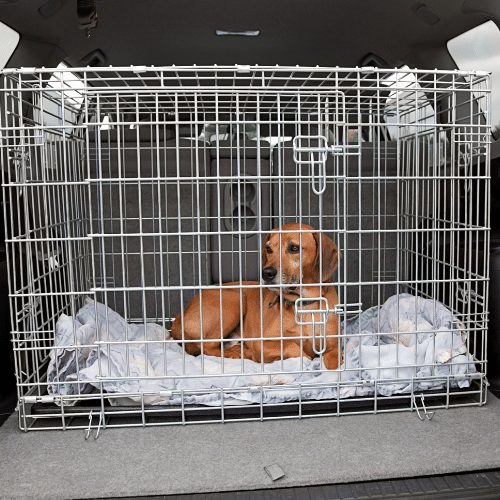Crate Training For Rescue Dogs
March 19, 2021 2021-06-10 12:54Did you just adopt a rescue dog? First of all: Congratulations on the new addition! Your dog is lucky to have you (and you are lucky to have scored him).
As you are getting him settled into the new home, you may wonder if you should crate train your dog. Should rescue dogs be crate-trained? Does it depend on how old they are? And how can you help a rescue dog enjoy his crate? Let’s dive in!
Table of Contents

Crate Training for Rescue Dogs: Pros and Cons
There are factors both for and against crate training a newly rescued dog. Which option is the best will depend on your family, your dog and your lifestyle. Let’s look in detail at how to make the right choice.
When to decide for crate training
Crates are a safe and secure place for having your dog while he is unsupervised. This can be especially useful for:
- Puppies
- Dogs that are strong chewers (such as many bully breeds)
- Dogs with potty training problems
- Dogs that live in a household with small kids
If your rescue dog falls into this category, crate training will come in very handy!
When to decide against crate training
On the other hand, if you rescue dog falls into the following categories, crate training will probably not be an instant success. You should expect to either put long-term work into it, or find a different way for your dog to stay alone:
- Adult dogs with prior crate aversion (some rescue dogs have been crated all day in their previous homes and have a strong apprehension against the crate now)
- Dogs with separation anxiety
- Senior dogs that already show signs of doggy dementia (they might become very frightened in the crate and hurt themselves).
Finding out about your dog’s history
Whenever possible, try to find out as much about your rescue dog’s former life as you can.
If the dog was brought to the shelter as a stray you might not know much. If he was surrendered by his prior owners however, they might have told the shelter a bit about the dog. Pay special attention to any kind of crate abuse they can inform you about: Sadly, many owners use the crate as a way to contain the dog 12-20 hours a day!
Dogs that have been crated for such extensive periods are likely to not take to crate training in their new home easily. This is because their prior experience is so bad that simply seeing the crate probably elicits a strong stress response in your dog already.
Some rescue dogs are overwhelmed by the stress and changes in their life and sleep very much. In this case, wait until your dog’s sleep schedule normalizes before starting crate training.
Crating your rescue dog based on his age and temperament
In general, crating is much more useful for puppies and very destructive dogs than for a laid-back adult dog. There is nothing “magical” about crating your dog that is going to solve any behavior problems such as reactivity or automatically train your dog.
Crating is first and foremost a type of management. This is going to be especially useful for young puppies that get into trouble as well as destructive dogs (for these, make sure to get an indestructible dog crate).
If your rescue dog has a tendency to tear up furniture (in fact – he may have been surrendered to the pound for exactly that reason!), crating can help you keep him and your belongings safe.
If you adopted a young puppy, then crate training will also come in handy during the potty training process: Dogs are much less likely to soil small spaces such as their crate. Especially at night it will be very handy useful to have your dog sleep in a crate so that he does not have potty accidents throughout your home as you are sleeping.

Senior dogs
Did you adopt a senior dog? If so – thank you. They often stay in shelters a long time without anyone even looking at them in between all the youngsters and puppies.
If your senior dog has never been crated before in his life, you should probably not start now. This is especially true if he already shows beginning signs of dementia. At some point in their life, aging dogs can easily forget where they are and become very anxious.
If your dog suddenly wakes up in a crate (that he has never known in his previous life), he might become scared and agitated and injure himself trying to get out.
If you have a senior rescue dog that you need to confine to a smaller area (for example because of potty troubles), choose a small room with tile floor instead. Laundry rooms, bathrooms or hallways work great for that.
6 Steps to crate training your rescue dog
Here is how to make crate training your newly adopted dog a success!
#1 Choose the right crate
Pick the crate with the dog in mind. A strong chewer such as a Pitbull will need a strong crate.
If you have a very small dog, a more lightweight crate will do. Of course, the crate should be big enough for the dog to lie down and stand up comfortable without being restricted.
#2 Start when the dog is tired
Many owners immediately set themselves up for failure in crate training by starting with a dog that is wide-awake and “ready to roll”. You should always begin to crate your dog when he is tired and ready for a nap. This could for example be after a long walk in the park or a training session.
Never try to put a dog who just woke up into a crate – you are only making life hard for yourself and your dog!
#3 Find a chew your dog loves
Experiment with bully sticks, frozen Kongs, yak milk chews etc. You want to have your dog attach the positivity and great taste of the chew with being in his crate. It is much easier for your dog to be in his crate and eat something than to just sit there and “obsess” about being unable to get out.
The more your dog loves his chew, the easier he will get used to being in his crate.
#4 Pair the crate and the chew
Of course, you want to supervise your dog during this step. Lure him into the crate with his chew and let him have it there. You can start with a short period at first: 10 or 15 minutes are plenty!
#5 Gradually increase the crating time
You want to slowly increase the time your rescue dog spends in the crate. Don’t go from 10 minutes straight to 5 or 6 hours – your dog will get scared and apprehensive! He should always see the crate as a place of rest and relaxation.
#6 Never use the crate as a punishment
You should never put your dog into the crate as a way to discipline him. If you want your dog to have positive associations with the crate, you cannot use it in punitive ways. Be sure to always make it a pleasant and comfortable place that your dog enjoys.
The Bottom Line
Crate training can be useful for your new rescue dog. Especially if you adopted a puppy or destructive dog, using a crate will let you provide a safe and secure place for him.
If you adopted a dog who was abused in his prior home and crated for unreasonable amounts of time (such as 15+ hours a day), you should refrain from crating him right away in your home. He will have built up so many negative associations that it will greatly impact his ability to settle into his new home. The same applies to senior dogs with dementia – crating is not always the best solution for them. If your rescue dog is scared and anxious in the crate, consider using another way of restricting him to one area instead – such as a mud room or laundry room.
If you decide to start crate training your rescue dog, make sure to follow a consistent step-by-step process. Dogs get used to crates the fastest if they are crated for short time intervals, several times a day. Build up the overall crating time gradually.


